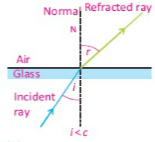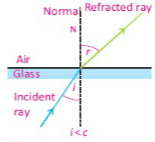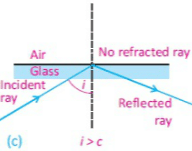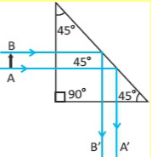Uses and applications of total internal reflection
When the angle of incidence becomes larger than the critical angle, no refraction occurs. The entire light is reflected into the denser medium. This is known as a total internal reflection of light. Prisms, binoculars, and optical fibers are a few applications and uses of Total internal reflection.
What is total internal reflection?

When a ray of light traveling in the denser medium enters into a rarer medium, it bends away from the normal. If the angle of incidence ‘i’ increases’ the angle of refraction ‘r’ also increases. For a particular value of the angle of incidence, the angle of refraction becomes 90°. The angle of incidence, that causes the refracted ray in the rarer medium to bend through 90° is called critical angle.
Keep Reading…
When does total internal reflection occur?

When the angle of incidence becomes larger than the critical angle, no refraction occurs. The entire light is reflected into the denser medium. This is known as a total internal reflection of light. It is shown in the figure below:

See also: Reflection of light
What are the conditions necessary for tirf ?
Total internal reflection takes place only when:
- The light should pass from a denser medium to a rare medium.
- The angle of incidence must be greater than the critical angle.
Examples of total internal reflection
- Underwater reflection of a turtle.
- Mirage is the image of some distant object that appears.
- A fish that looks like water above as a mirror.
Applications of total internal Reflection
- Optical fibres
- Endoscope
- Periscope
- Binoculars
- Prisms
Total internal reflection in the prism
Many optical instruments use right-angled prisms to reflect a beam of light through 90° or 180° (By total internal reflection) such as cameras, binoculars, periscope, and telescopes.
One of the angles of the right-angled prism is 90°. When a ray of light strikes the face of the prism perpendicular, it enters the prim without deviation and strikes the hypotenuse at an angle of 45°.
Since the angle of incidence of 45° is greater than the critical angle of the glass which is 42°, the light is reflected by the prism through an angle of 90°.
Two such prisms are used in periscope. The light is reflected by the prism at an angle of 180°. Two such prisms are used in binoculars.
Tirf use in Optical Fibre
Total internal reflection is used in fiber optics which has several advantages in the telecommunication field. Fiber optics consist of hair-size threads of glass or plastic through which light can be traveled.
The inner part of the fiber optics is called the core that carries the light and an outer concentric shell is called cladding. The core is made of glass or plastic or has a relatively high index of refraction. The cladding is made of glass or plastic but of relatively low refractive index. Light entering from one end of the core strikes the core-cladding boundary at an angle of incidence greater than the critical angle and is refracted back into the core. In this way, light travels many kilometers with a small loss of energy.
See Also: Polarization of light
Light Pipe
The light pipe is a bundle of thousands of optical fibers bonded together. They are used to illuminate inaccessible places, doctors or engineers. For example, doctors view inside the human body. They can also be used to transmit images from one point to another.
Endoscope
An endoscope is a medical instrument used for exploratory diagnostics and surgical purposes. An endoscope is used to explore the interior organs of the body. Due to its small size, it can be inserted through the mouth and thus eliminates invasive surgery.
The endoscopes used to examine the stomach, bladder, and throat are called the Gastroscope, Cystoscope, and Bronchoscope respectively. An endoscope uses two fiber-optic tubes through a pipe.
A medical procedure using any type of endoscope is called endoscopy. The light shines on the organ of the patient to be examined by entering through one of the fiber tubes of the endoscope. Then the light is transmitted back to the physician’s viewing lens through the outer fiber tube by the internal reflection.
Flexible endoscopes have a tiny camera attached to the end. The doctor can see the view recorded by the camera on a computer screen.
Applications of total internal reflection (video)
Watch also:
Related searches about Total internal reflection:
Thanks a lot.This article helped me in my homework